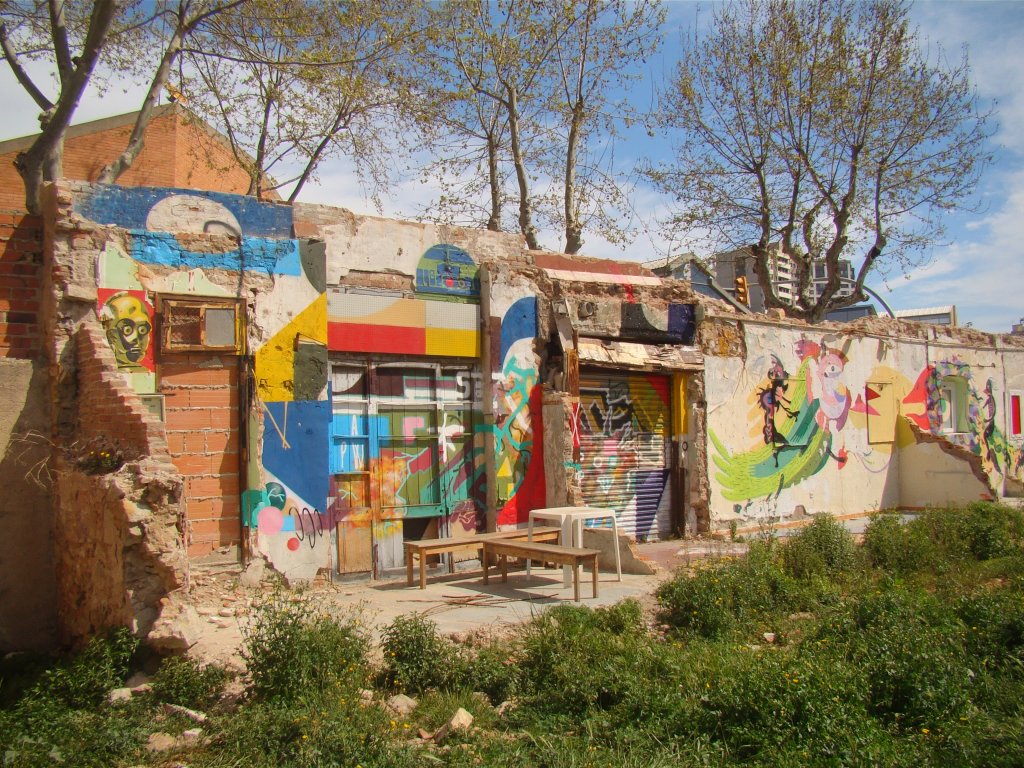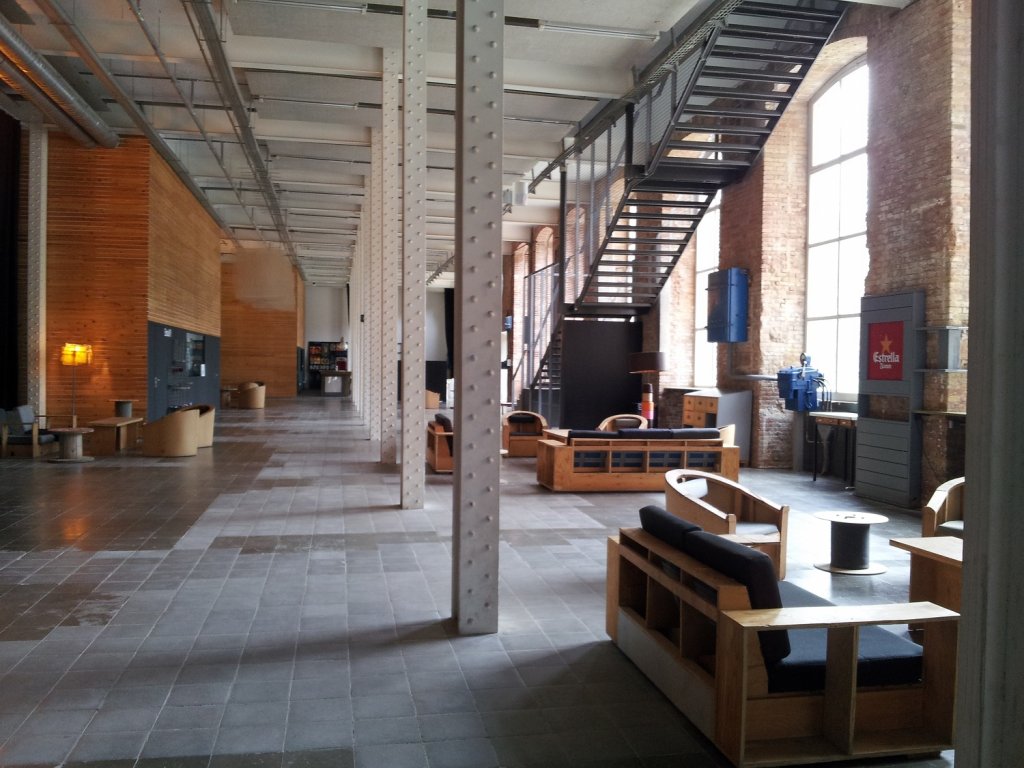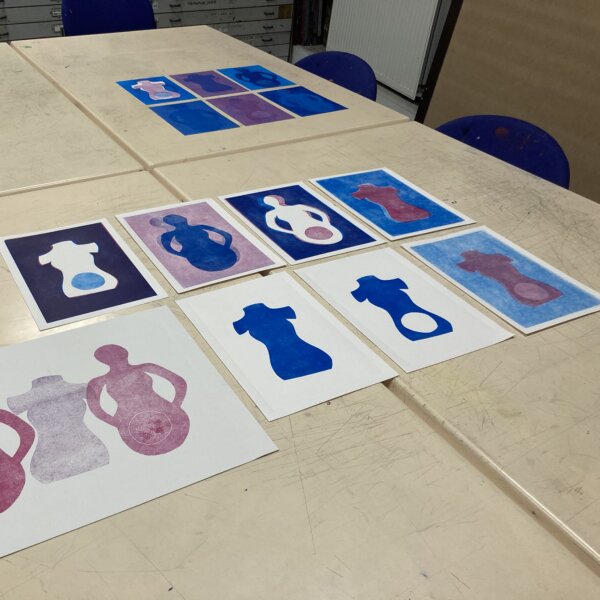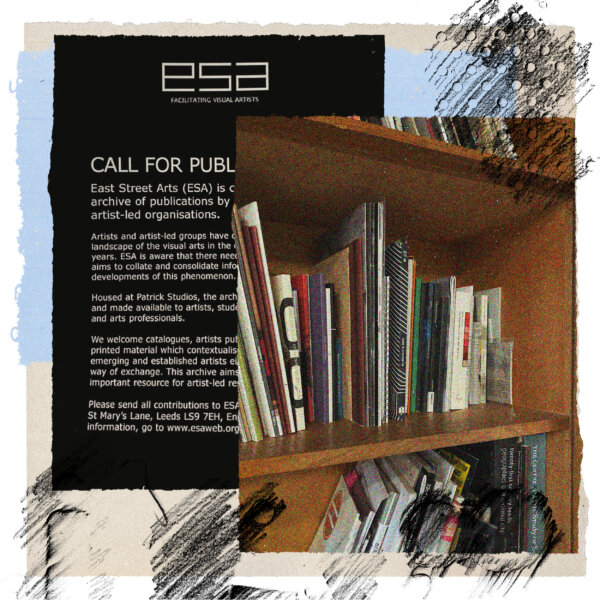Following a nine-course opening evening meal at a vegetarian restaurant, the group embarked on a packed three-days exploring the art and culture of the Catalan capital.
On her return, Hondartza provided a travelogue of the visit which you can read below:
Day 1
‘Rise and shine’ and off we went to our first day of appointments at Hangar and MOB (Makers of Barcelona). Hangar is a centre for art research and production situated in an old industrial enclave in Poblenou. For its understated entrance Hangar is a vast space including a detached residential house, a studio, workshops and office buildings. Marta, in charge of research, gave us a tour and explained everything they do, ranging from workshops, collaborations, professional development and residencies.

Hangar, Barcelona
MOB, meanwhile, is an altogether very different space with a very different feel. When we arrived, they were putting the final touches to their new café area, and we met up with Cecilia, director and mastermind behind the project.
Cecilia was really passionate about the importance of artists (and people in general) coming together to make things happen. She told us the story of how she came to Barcelona, her architectural background, and how she made the journey from not knowing anybody to setting up MOB about two years ago.
In both places, we were also told how artists are only allowed to work in studios for a maximum of two years, a common approach across Barcelona. Many organisations feel this method helps support more artists – for a relatively short but more intense period of time. Artists are then forced to find a new studio, keeping a constant creative flux within the city and beyond. My question is what happens afterwards? As an artist myself, a studio is really important as a stable centre in which to establish artistic ‘roots’ without the pressures of any particular project.
The first days’ meetings were done and the group split into smaller parties. Some went exploring, some went shopping, and some went for a nap. I went with a few of the girls to get some Tapas.
After a bit of indecision we found a little restaurant with a very enthusiastic and loud waiter. The food was very nice, the Sangria not so much, but I was happy to eat as many ‘padrón’ peppers as I could to the amazement of my fellow dining companions – the Spanish green peppers are one of the foods I miss the most. After a first night without much sleep, I was planning an early night, but away from the apartments a large portion of the group found the joys (and later consequences) of €1 beers and had to endure some difficulties the next day…
Day 2
The first visit the next day was to Fabra i Coats. None of us had ever been there before, but we were intrigued about the space and were looking forward to meeting Ruth who was going to show us around. Fabra i Coats is the only one of Barcelona’s Art Factories that is solely run by the local authority. The name has an interesting connection to the UK – Fabra i Coats was originally a thread factory that came from a partnership between a Catalan and an English businessmen.
And what an amazing space Fabra i Coats is! The ground floor is the public space, around 4000 square metres, and used for concerts, performances, talks, exhibitions, screenings, and any other creative event you can think of. The next two floors, keeping with the same ‘open-plan’ feel, were the office/start-up spaces and the artists’ studios.
It was a bit disappointing to see the artists’ studios so quiet and empty, nobody was working there at the time, and there were not many signs of activity either, no arty ‘leftovers’. Sadly the venue doesn’t allow for messiness, which for an art production space is a bit limiting.

Fabri i Coats, Barcelona
In the afternoon we went to have lunch at Mitte Barcelona where Alejandra, the founder and director, gave us an introduction about their areas of activity. Mitte is an open plan café with a very active creative agenda, including exhibitions and workshops. At the entrance is the gallery that often focuses on work by illustrators or fine artists. The walls around the café are dedicated to photography and at the back there is a space for meetings or workshops. A separate window is reserved for displaying designers’ work that changes every month. On this occasion the whole place had been taken over by a project dedicated to Japanese culture to commemorate the victims of the earthquake in Japan in 2011.
Soon after lunch part of the group went to visit La Sagrada Familia, which really is a must if you go to Barcelona. I went last year and it definitely exceeded my expectations, strange and beautiful at the same time. This time I decided to skip it because I wanted to go ride the cable car I had spotted on my previous visits to the city and had not had the chance to take. The Transbordador goes over the harbour area, a barely 10 minute ride in a straight line from one end to the other of three towers. It was fantastic to hover over the edge of the city, over the docks and the beach, looking out to the open sea.
Day 3
The last day was busy with visits, and our first port of call was to FAD (Arts and Design Promotion). Founded in 1903, FAD has become the first centre of reference for design and architecture in Catalonia and Spain thanks to its commitment to promoting creative culture through exhibitions, professional talks, prizes and events. They have only recently moved into a new building, so the smell of fresh paint still hung in the air. Jordi, project manager of FAD, gave a tour of the building.
We were then given a tour of the materials department, the Materfad. This blew many of the groups’ minds! A hands-on archive of all possible materials to use in projects and design – If you can think it, it was there. Any material that is commercially available had a sample in this great library, and each was labelled with a reference number linking it to a database. Anyone in any creative endeavour would be spoilt for choice here.
After FAD, we had a couple of hours for lunch and the group split again. Some people wanted a taster of the beach; it was a lovely sunny day after all. I managed to squeeze a visit to the maritime museum with fellow artist Lorna, as we are both working in a sea-related project and we couldn’t miss the opportunity.
The afternoon took us all to the University to meet with two sociologists who were doing research into the creative community of Poble Nou. It was really interesting to hear Marc and Matías talk about the political and cultural journey of the neighbourhood, from artist initiated projects to the ups and downs of council attempts to regenerate an area through cultural initiatives that didn’t always seem properly thought out.
The day ended with a meeting at Experimentem, a very understated arts education centre in the Gracia neighbourhood. This would be my favourite place to live in the city. All the streets near Experimentem are full of great looking cafes and independent shops, with a very cosy feeling; you almost forget you are in a big city.
Experimentem’s website describes it as an educational institution for contemporary art and creative processes. The company’s main activity is the design and implementation of various artistic and educational projects. They also offer a residency programme, where the main goal is to link the resident artists with the education courses taking place and their EART school programme offers creative activities aimed at babies and children.
Situated in an old school, we had a chance to hear all about their programme from Antonia in one of their project rooms, just off a lovely patio which acts as an informal meeting point for the artists. This was a great place to end our trip. We also had a chance to do an informal presentation about East Street Arts and it was great to meet the artists working there, see their studios and talk about their work. From the whole trip, I believe Experimentem has the most in common with East Street Arts. There are similarities in the journeys of both organisations; their history, core values and the way they both share an open and organic attitude to working with artists.
During our previous trip to Lille in 2012 we saw a lot of art, from the commercial and spectacular to the alternative and subversive. Barcelona turned out to be more about the spaces that host art and the artists. These spaces were, incidentally, empty or in-between projects. This is in no way a reflection of the city’s current state of affairs, but perhaps an indication of the changing focus from object to process that many organisations alluded too. Nevertheless, the bare walls did not obscure the potential for great projects to come, and in a city like Barcelona, there is never a shortage of culture to delight on.
Just remember, there are two main things you must always bring with you: time and enthusiasm. Sorry, three – comfy shoes will always help.
Originally posted in May 2014
Other things!
-
News
Artist-Led Housing: Histories, Residencies, Spaces - available to buy!
Architectural researcher Dr Jonathan Orlek's brand-new publication, Artist-Led Housing: Histories, Residencies, Spaces is now available to buy.
-
News
Taipei Residency: Artist Call Out
Are you an artist using sound and audio-visual media at the core of your practice? Do you want to collaborate with communities and other artists to develop new artworks? Apply now! Deadline 12pm, Sunday 5 May 2024.
-
News
Leeds Creative Labs Follow on Fund: Herfa Martina Thompson Dr Zoe Tongue
Visual artist Herfa Martina Thompson and Law lecturer Dr Zoe Tongue first collaborated as part of Leeds Creative Labs, a programme that partners artists and academics, initiated by the University of Leeds’ Cultural Institute and facilitated in partnership with East Street Arts.
-
History
Listen to the Sounds of New Briggate
Sounds of New Briggate is our podcast series - hosted by local people, telling local stories - which celebrates New Briggate, a unique and vibrant high street in the heart of Leeds.
-
News
Artist Mohammad Barrangi’s large-scale murals come to the streets of Leeds
We're working with Leeds-based, Iranian-born illustrator and printmaker Mohammad Barrangi to bring three large-scale paper murals to the streets of Leeds.
-
Artist support
Submit your publications to our exhibition and learning library
Do you make books or printed materials on artist-led housing, live/work spaces, civic practice or living archives? Contribute now! Together we can learn.








